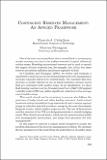Artículo
Contingent reserves management: an applied framework
Date
2006Abstract
One of the most serious problems that a central bank in an emerging market economy can face is the sudden reversal of capital inflows (or sudden stops). Hoarding international reserves can be used to smooth the impact of such reversals (see, for example, Lee, 2004), but these reserves are seldom sufficient and always expensive to hold. In Caballero and Panageas (2005), we derive and estimate a quantitative model to assess the (noncontingent) reserve management strategy typically followed by central banks. We conclude that this strategy is clearly inferior to one in which portfolios include assets that are correlated with sudden stops. As an illustration, we show that holding contracts on the Standard and Poor’s (S&P) 100 implied volatility index (VIX) can yield a significant reduction in the average cost of sudden stops.
Collections
View/


